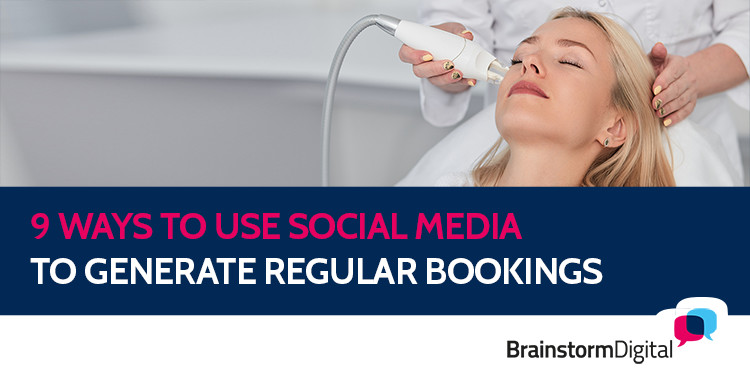
Practically every aesthetic clinic, medspa and cosmetic surgeon in the world is on social media. It’s a great way to connect to patients – and when your competition is building up a following, you can’t afford to be left out.
But how do you use your social media presence to generate new business – not just sporadically, but reliably and consistently?
We asked 8 top clinic owners from 4 continents how they have developed a social media presence that isn’t just “nice to have”, but builds their business.
Here are their top tips.
Be Strategic
Do not launch your social media presence without seriously considering your goals and developing a content strategy to match, says Dr Justin Harper, founder of Juvly Aesthetics, one of the fastest-growing cosmetic dermatology practices in the United States with 11 locations in 5 states.
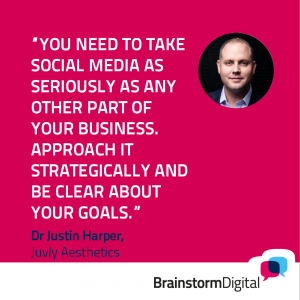 “You need to take it as seriously as any other part of your business, and if your goal is to book new business, then focus on content that does just that,” he says. “I see clinics that frequently produce off-topic content, using it to display their owners’ personal life, which is fine – but it doesn’t build your business.
“You need to take it as seriously as any other part of your business, and if your goal is to book new business, then focus on content that does just that,” he says. “I see clinics that frequently produce off-topic content, using it to display their owners’ personal life, which is fine – but it doesn’t build your business.
“While there is a lot of value in sharing the back story and creating a sense of connection, that has to be a minority of the content, at least until you’re famous and people just want to be part of your life.”
In order to develop an effective strategy, not only should you consider carefully how you will generate business from your social media presence, but you must work out how you will look and sound different to your competition.
“The social media environment is different to 5-10 years ago,” says Dr Harper. “The algorithms are much more sophisticated and you have to be better now that every clinic is on social media. Better – and different. If you post the same images as everyone else, it’s hard to differentiate and compete.”
“Think about what your niche is – what it is that you are specifically good at and try to find a way to tell that story.”
Create patient-centric content
For Victor Snyders, CEO of Skin Renewal Aesthetic Clinics, a chain of clinics in South Africa, a good social media strategy starts not with your clinic or treatments – but with the patients.
“People go on social media to indulge in material they want to hear. If you post content that you want to tell them, but they do not want to hear, they will unfollow you.
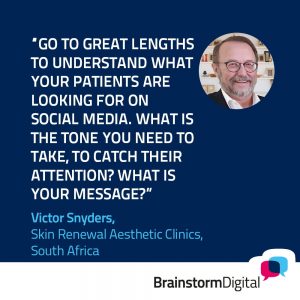
“So you need to spend a lot of time understanding what it is that your patients are looking for. What is the tone you need to take, to catch their attention? What is your message?”
Skin Renewal has developed a unique, rigorous process for understanding their target market.
Every two years, they run an “Archetype Exercise”, where each of their 16 branches identifies five patient personas who are responsible for 80% of their turnover. Then, over a couple of months, each clinic researches and develops in-depth profiles of these archetypes.
“We have a very diverse population and each geographical area, even within one city, might have very unique patient types,” says Snyders. “Out of the 80 archetypes, we can generally narrow down 30-35 which cut across several branches.”
As well as creating a written document, the clinics present their findings to management by role-playing their personas (“It’s a team-building exercise as well,” says Snyders).
In character, “they tell me about themselves, and then I interview them and ask questions like, how do you spend your Sunday mornings? Where do your kids to go school? Which social media platforms do you use, and how are you using them?”
This ensures that the clinics have a rich understanding of their patient’s habits, personalities, influences and preferences – not just their broad demographic information.
The clinics use the archetypes to create social media content which resonates deeply with their existing patients. But crucially, they can also use personas developed by other branches to attract new types of patients to their locations, if research shows that they are present in their catchment area.
“We can build on each other’s successes,” he says.
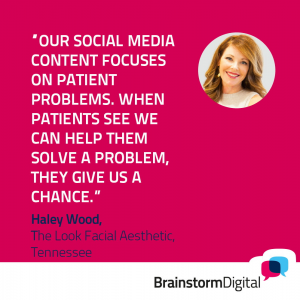 An ocean away, being relevant – and helpful – to patients on social media is also key for Haley Wood of The Look Facial Aesthetic in Tennessee.
An ocean away, being relevant – and helpful – to patients on social media is also key for Haley Wood of The Look Facial Aesthetic in Tennessee.
“We always start with a patient problem,” she says. “If we hear people talking about an issue that is really bothering them, we’ll show them how to get around it. Or we’ll address a fear, like ‘I don’t want to look frozen’.
“Once they hear that we can help them solve a problem, they’re willing to give us a chance.”
Use a strong Call-to-Action
“Too many clinics are caught up posting pretty images, but don’t use a call-to-action,” says Deb Farnworth-Wood, who grew the Australian Skin Clinics franchise to over 60 locations before selling, and now operates the Ultimate Skin & Body Clinic.
If you want your social media followers to get in touch, you have to tell them so explicitly. You cannot rely on them to see your posts, and then decide to contact you without any further prompt.
And make it easy for them.
Tell them exactly how they can get in touch. Then make sure they can follow through.
For example, if you tell them to “Call now” and there is only one phone line coming to the clinic, you will lose the potential sale if that phone line is busy.
Finally, give your followers a compelling reason to buy now by including a strong offer.
“People like to procrastinate,” says Farnworth-Wood. “Make your offers time-limited or subject to availability, then stick to that. Your offers need urgency.”
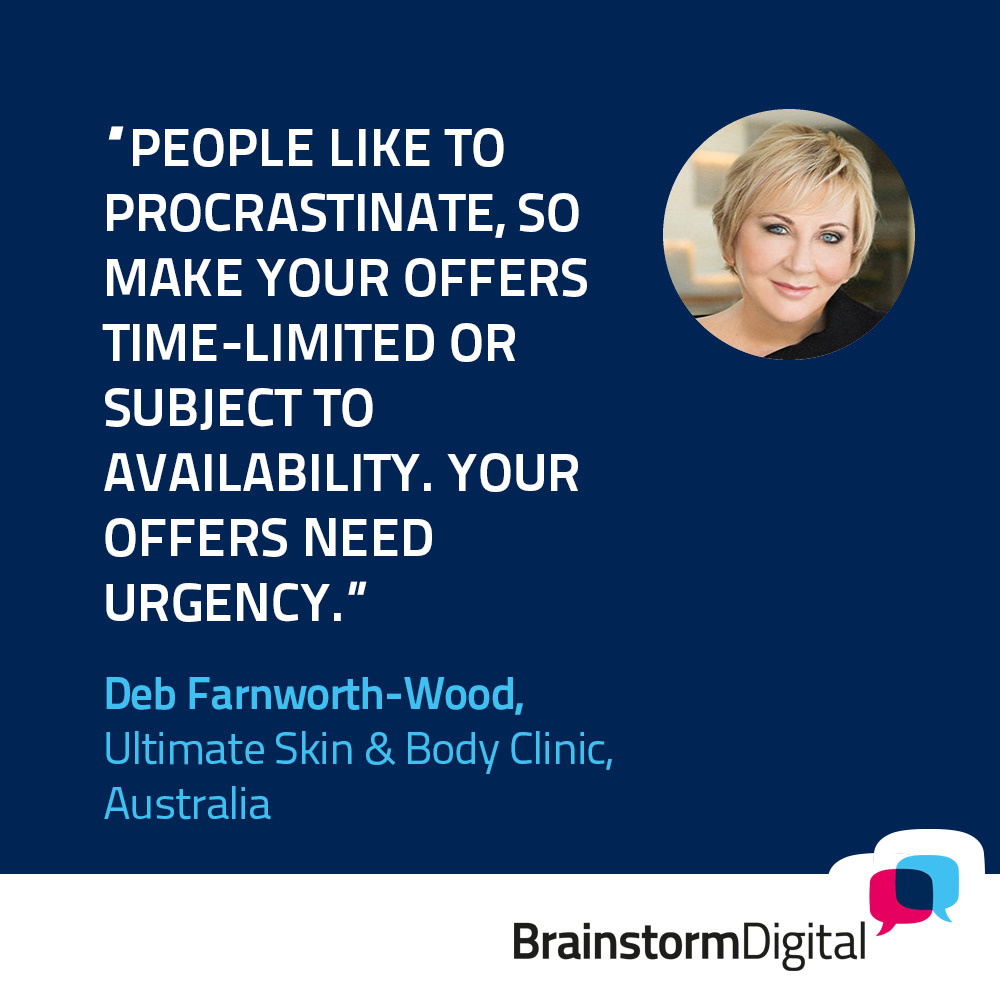
Make one person responsible
Another way to ensure that inquiries you receive online convert to new business?
“Assign a knowledgeable staff member as your key contact on all social media channels,” advises Dr Suzanne Kilmer, Founder of the Laser and Skin Surgery Center of Northern California.
“This employee should be available to respond to any comments or messages in a prompt manner and encourage any interested parties to schedule an appointment for a consultation.”
Junior members of staff are less likely to be able to follow up with inquiries knowledgeably. And of course, the faster you respond to inquiries, the more likely they are to convert – so speed is of the essence.
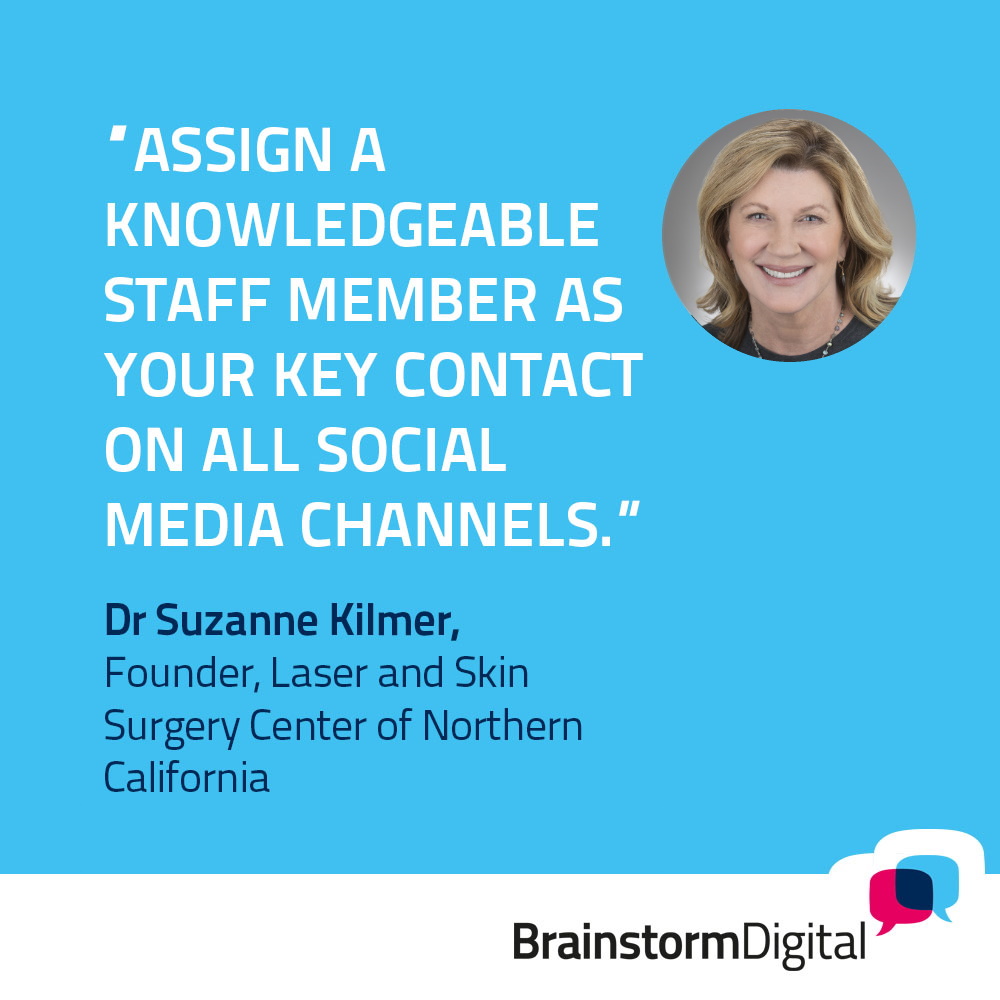
Use paid ads as well as organic content
Evolution Laser Clinic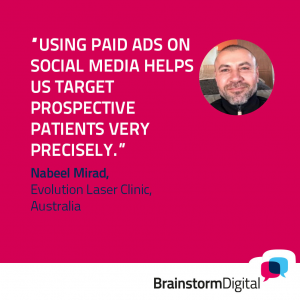 , a chain of clinics in Australia, combines extensive organic content with paid ads on Facebook and Instagram.
, a chain of clinics in Australia, combines extensive organic content with paid ads on Facebook and Instagram.
It works particularly well, says founder Nabeel Mirad, because you can target your ideal patients very precisely instead of waiting for them to find you.
“If we are launching a new treatment or have a particular sale on, we customize and modify all our paid ads to reach the right people, showing them relevant offers,” he says. “We are very competitive and that entices a lot of our audience to want to book with us.”
Dr Ash Dutta of Aesthetic Beauty Centre in the UK agrees that the ability to zero in on particular segments through social media advertising is very powerful. However, he cautions that it is easy for clinics to get their targeting wrong.
For example, it may be tempting to target patients in high-income brackets – but this can be misleading.
“I have seen people from average income backgrounds spend a lot of money and many very wealthy patients fight for £10. We veer away from that.”

One thing to avoid focusing on…..?
The clinics we spoke to frequently expressed skepticism about using lots of before-and-afters on social media.
“So many other clinics are doing it, you would just get lost in the clutter,” says Victor Snyders. “We use them a lot more in the consultation process.”
“Before-and-afters don’t really help you stand out,” agrees Dr Vincent Wong, who was named one of MyFaceMyBody’s Ultimate 100 Global Aesthetic Leaders for 2019. “You are rarely the only clinic performing a particular procedure, or the only one who can achieve those results.”
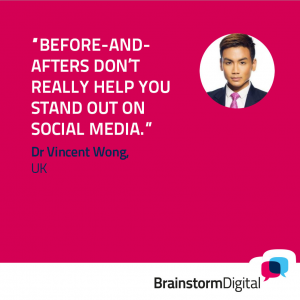 Be personal
Be personal
So, how does Dr Wong recommend standing out instead?
“Show your personality.”
Not only is this something no one else can replicate, but it can help you build a strong bond with your target market and subtly build up your authority.
And patients like it, adds Haley Wood.
“We see higher engagement rates when we get personal,” she says, noting that video content is particularly popular. “It allows people to get a sense of who you are and see that you’re authentic.”
However, Dr Wong cautions, you need to strike a balance between personal and professional.
“You can’t make it truly personal – this isn’t a personal account,” he says. “The key word is ‘relatable’. I share events from my real life, but in a professional capacity.
“So, for example, I was judging Miss Universe – I put up pictures of that. It’s showcasing my specialty without making it very clinical.
“I also work with Allergan on different projects, and patients who see that on social media will understand that they’re in safe hands without a lot of before-and-after shots.”
The pictures and posts he shares on social media are a strategic choice, to appeal to his target market – in his case, a relatively young audience.
“You have to know what your branding stands for, who you are and what your values are, and what you are trying to portray,” he says. “Imagine your target patient: How would they like to see their doctor? You have to know your audience to get it right.”
Invest in quality images
Given the competition on social media nowadays, clinics need to plan the images they post very carefully, says Dr Harper.
“I don’t think you can succeed on social media anymore without some production quality,” he says. “If you’re taking bad pictures, or it’s badly lit or poorly produced, it won’t do well.
“If you want to be on social media, make the investment. Learn how to take good photos, invest in the proper camera equipment, watch YouTube tutorials on how to do it well.”
And make sure the images you use reflect your brand.
“If you’re a luxury brand, your images need to feel luxurious. If you’re results-driven, you have to put good work out there. If what you post is average or worse, it’s going to hurt you – not help you.”

Balance your brand vs individual clinics
Clinics with multiple locations face a dilemma on social media: Should each clinic have its own social media presence – or should communications come from the brand?
If every clinic has its own account, and that’s all you’re doing, it’s hard to scale the business, argues Victor Snyders.
But patients have a relationship with their branch, their doctor and their therapist which is quite intimate, and which varies from clinic to clinic. They don’t necessarily have as deep a relationship with the brand.
His answer is to operate on both levels at once.
Each one of his clinics has its own Facebook and Instagram page, which promotes local content, such as staff changes, social responsibility programs and in-clinic events.
“It’s the things those patients are aware of and see when they’re in the branch.”
Meanwhile, Skin Renewal has an overall brand strategy, and the chain as a whole has its own social media presence, which focuses on company news (and occasionally draws on local news in individual branches).
“For best results, there is a tension there between being scaleable and being personal which you have to constantly try and balance,” Snyders concludes.
Miriam Shaviv helps aesthetic clinics get your patients through your doors again and again, so you can quickly grow your revenue while minimizing your dependence on online advertising.
Check out this video case study to learn about the 3-step system that helped one practice generate an additional $183,000 from a patient database of just 3,000 people.





